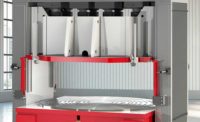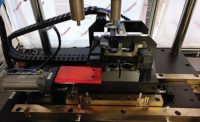For Ekoligens in Kungälv, Sweden, sustainability is not just an important part of operations: It’s the basis for its business idea. The company is the first in the world to mass-produce 3D formed garment hangers made from sustainably sourced cellulose. Produced with sustainable energy, the recyclable, compostable hangers lay the groundwork for significantly reducing the fashion industry’s environmental impact.
“Considering more than 10 billion plastic clothes hangers are produced globally each year, there is an enormous potential for us to help the fashion industry in transitioning from fossil-based material sources to renewables and to reduce plastic waste,” says Ekoligens’ CEO Christian Capurso.
Ekoligens was founded by Jonas Skoglund and Patrik Enbacka in 2013. In collaboration with the Swedish forest and pulp industry, they set out to develop a high quality replacement to plastic using a sustainable material close to home: the Scandinavian forest. The company developed a flat, cellulose-based hanger in 2014, and it introduced a 3D formed hanger four years later.
Numerous fashion companies have shown interest in Ekoligens’ products, but changing habitual purchasing patterns and established supply chains takes time. That is why Ekoligens has spent the past two years focusing on reinforcing customer collaborations and developing its production process and product offerings to truly fulfill the needs of the market.
For its products, Ekoligens sources cellulose fibers certified by the Forest Stewardship Council, an international nonprofit organization established that promotes responsible management of the world’s forests. The raw materials come from local forests and manufacturers to avoid any unnecessary transport.
Then, through a proprietary technique, the raw material is milled into fibers and converted into the base material for hangers. A press line forms the fibers into blanks and then into hanger bodies. Any excess material is collected and reused to minimize waste.
Finally, components made from recycled steel, such as hooks and clips, are attached to the hangers. At the customer’s request, hangers can be customized with paint or logos.
The backbone of Ekoligens’ production facility is the fully automated forming line consisting of two hydraulic presses and a number of SpeedFeeder gantry robots from AP&T Group. At full capacity, the line can produce more than 2,000 hangers per hour. The line was delivered in the summer of 2021 and has since been integrated with other factory equipment, tested, tweaked and used for small-scale production, all with the help of AP&T.
“Sustainability is central to AP&T. We’re happy to be able to provide expertise and equipment that will contribute to more sustainable products and production, for instance, through low energy consumption, short cycle times, high reliability and long service life. Ekoligens has an exciting product with great room for growth, making our collaboration strategically interesting,” says Christian Koroschetz, Ph.D., chief sales officer at AP&T.
AP&T develops press concepts that are optimized for different types of operations and applications. Standard lines are equipped with hydraulic presses ranging from 1,000 to 50,000 kilonewtons, but AP&T can custom-make presses for higher forces. The company’s lines are used for forming, embossing, press hardening and deep drawing sheet metal and other materials.
Press lines are based on standardized modules for frames, hydraulics and control systems together with process control, which can be combined to form a number of variations. The presses can be delivered as individual machines or as components of a complete, fully integrated production line.
For Ekoligens, the next step is to ramp up production. “It’s a very important step for us, and we are grateful to be able to take it with a well-established partner like AP&T. Our ambition is to continue to grow our production facilities in Europe and eventually into the other parts of the world where we see customer need. Through this established, trustworthy partnership, our companies will continue to share risks and opportunities that allow a sustainable future for both of us,” says Capurso.
In the future, Ekoligens hopes to use its cellulosic material to make other products, such as eyewear. It’s also looking to incorporate recycled paper into its products.
For more information on forming presses, click www.aptgroup.com.






